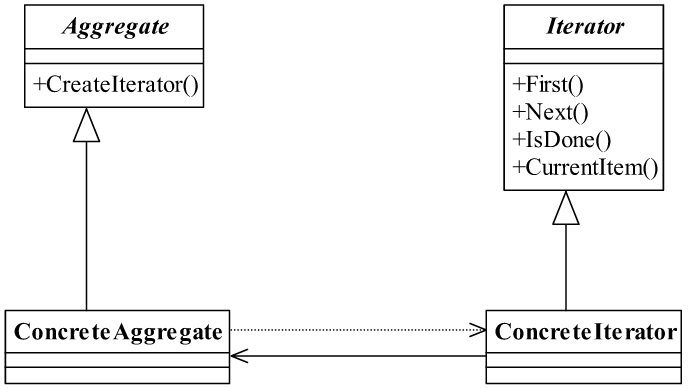迭代器模式
迭代器模式提供了遍历容器的方便性,容器只要管理增减元素即可,需要遍历的时候交由迭代器进行。
比如Set、Map、List等容器的iterator。
定义
迭代器是为容器服务的,它提供一种方法访问一个容器对象中的各个元素,而又不需要暴露该对象的内部细节。

实现
Iterator
抽象迭代器负责定义访问和遍历元素的接口。
first() 获取第一个元素;
next() 访问下一个元素;
hasNext() 是否还有下一个;
1
2
3
4
5
| public interface Iterator<E>{
E next();
boolean hasNext();
boolean remove();
}
|
ConcreteIterator
具体迭代器要实现迭代器接口,完成容器元素的遍历。
1
2
3
4
5
6
7
8
9
10
11
12
13
14
15
16
17
18
19
| public class ConcreteIterator implements Iterator<E>{
private Vector<E> v = new Vector<>();
public int cursor = 0;
public ConcreteIterator(Vector _vector){
this.v = _vector;
}
public boolean hasNext(){
return this.cursor != this.v.size();
}
public E next(){
return this.hasNext() ? this.v.get(this.cursor++) : null;
}
public boolean remove(){
this.v.remove(this.cursor);
return true;
}
}
|
Aggregate
抽象容器角色负责提供创建具体迭代器角色的接口, 必然提供一个类似于createIterator()的方法。
1
2
3
4
5
| public interface Aggregate<E>{
void add(E e);
void remove(E e);
Iterator iterator();
}
|
Concrete Aggregate
具体容器实现容器接口定义的方法,创建出容纳迭代器的对象。
1
2
3
4
5
6
7
8
9
10
11
12
| public class ConcreteAggrate implements Aggregate<E>{
Vector v = new Vector();
public void add(E e){
this.add(e);
}
public Iterator<E> iterator(){
return new ConcreteIterator<>(this.v);
}
public void remove(E e){
this.remove(e);
}
}
|
